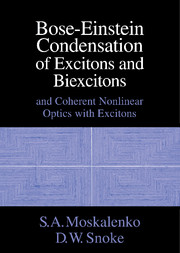Book contents
- Frontmatter
- Contents
- Preface
- 1 Introduction
- 2 Basic Theory of Bose–Einstein Condensation of Excitons
- 3 The Interaction of Condensed Excitons with Lattice Phonons
- 4 Bose–Einstein Condensation of Biexcitons
- 5 Phase Transitions and Thermodynamics of High-Density of Excitons
- 6 The Optical Stark Effect and the Virtual Bose Condensate
- 7 Bose–Einstein Condensation of Mixed States of Excitons and Photons
- 8 Nonequilibrium Kinetics of High-Density Excitons
- 9 Coherent Nonlinear Optics with Excitons
- 10 New Directions
- Appendix A: Properties of Excitons in Cu2O
- Author Index
- Subject Index
2 - Basic Theory of Bose–Einstein Condensation of Excitons
Published online by Cambridge University Press: 04 August 2010
- Frontmatter
- Contents
- Preface
- 1 Introduction
- 2 Basic Theory of Bose–Einstein Condensation of Excitons
- 3 The Interaction of Condensed Excitons with Lattice Phonons
- 4 Bose–Einstein Condensation of Biexcitons
- 5 Phase Transitions and Thermodynamics of High-Density of Excitons
- 6 The Optical Stark Effect and the Virtual Bose Condensate
- 7 Bose–Einstein Condensation of Mixed States of Excitons and Photons
- 8 Nonequilibrium Kinetics of High-Density Excitons
- 9 Coherent Nonlinear Optics with Excitons
- 10 New Directions
- Appendix A: Properties of Excitons in Cu2O
- Author Index
- Subject Index
Summary
The Bogoliubov Model of the Weakly Nonideal Bose Gas
In this chapter we review the basic theory of Bose-Einstein condensation (BEC) of excitons. To start, this means we must review the basic theory of BEC of any kind of particle, the theory known as the Bogoliubov model, after the foundational contributions made by N. N. Bogoliubov. This model introduces all the strange things associated with BEC: spontaneous symmetry breaking, off-diagonal long-range order (ODLRO), macroscopic occupation of a single quantum state, etc.
It is often said that physicists who spend years studying quantum mechanics eventually warp their intuition so much that things like ODLRO seem normal. It is well worth stepping back every now and then to think about just how strange a Bose condensate is. First, consider the idea of spontaneous symmetry breaking. Many systems exist in which the underlying physics, expressed in the Hamiltonian, do not favor one state over another. The a priori probability of occupation of the different states by a particle is equal, i.e., symmetric. Nevertheless, in some cases, thermodynamics requires that a macroscopic number of particles must somehow “choose” one of the states preferentially. If they did not, the system would not be in equilibrium, i.e, could not have a definable temperature. If the particles preferentially choose one state, then the underlying symmetry has been broken.
In the context of magnets, the breaking of the symmetry of the magnet (to have all its constituent dipoles lined up one way and not another) is energetically favored, since there are terms in the Hamiltonian that give lower energy for aligned dipoles, e.g., μS1 · S2.
- Type
- Chapter
- Information
- Bose-Einstein Condensation of Excitons and BiexcitonsAnd Coherent Nonlinear Optics with Excitons, pp. 29 - 81Publisher: Cambridge University PressPrint publication year: 2000



